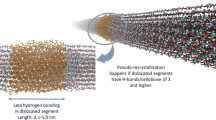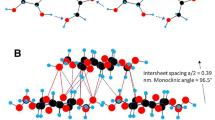Abstract
The quintessential form of cellulose in wood consists of microfibrils that have high aspect ratio crystalline domains embedded within an amorphous cellulose domain. In this study, we apply united-atom molecular dynamics simulations to quantify changes in different morphologies of cellulose. We compare the structure of crystalline cellulose with paracrystalline and amorphous phases that are both obtained by high temperature equilibration followed by quenching at room temperature. Our study reveals that the paracrystalline phase may be an intermediate, kinetically arrested phase formed upon amorphisation of crystalline cellulose. The quenched structures yield isotropic amorphous polymer domains consistent with experimental results, thereby validating a new computational protocol for achieving amorphous cellulose structure. The non-crystalline cellulose compared to crystalline structure is characterized by a dramatic decrease in elastic modulus, thermal expansion coefficient, bond energies, and number of hydrogen bonds. Analysis of the lattice parameters shows that Iβ cellulose undergoes a phase transition into high-temperature phase in the range of 450–550 K. The mechanisms of the phase transition elucidated here present an atomistic view of the temperature dependent dynamic structure and mechanical properties of cellulose. The paracrystalline state of cellulose exhibits intermediate mechanical properties, between crystalline and amorphous phases, that can be assigned to the physical properties of the interphase regions between crystalline and amorphous cellulose in wood microfibrils. Our results suggest an atomistic structural view of amorphous cellulose which is consistent with experimental data available up to date and provide a basis for future multi-scale models for wood microfibrils and all-cellulose nanocomposites.







Similar content being viewed by others
References
Agarwal UP (2006) Raman imaging to investigate ultrastructure and composition of plant cell walls: distribution of lignin and cellulose in black spruce wood (Picea mariana). Planta 224(5):1141–1153. doi:10.1007/s00425-006-0295-z
Andersson S, Serimaa R, Paakkari T, Saranpaa P, Pesonen E (2003) Crystallinity of wood and the size of cellulose crystallites in Norway spruce (Picea abies). J Wood Sci 49(6):531–537. doi:10.1007/s10086-003-0518-x
Apol E, Apostolov R, Berendsen H, Van Buuren A, Bjelkmar P, Van Drunen R, Feenstra A, Groenhof G, Kasson P, Larsson P (2010) GROMACS user manual version 4.5. 4. Royal Institute of Technology and Uppsala University, Stockholm
Berendsen HJ, Postma JPM, van Gunsteren WF, DiNola A, Haak J (1984) Molecular dynamics with coupling to an external bath. J Chem Phys 81(8):3684–3690
Bergenstrahle M, Berglund LA, Mazeau K (2007) Thermal response in crystalline I beta cellulose: a molecular dynamics study. J Phys Chem B 111(30):9138–9145. doi:10.1021/Jp072558i
Bergenstrahle M, Mazeau K, Berglund LA (2008a) Molecular modeling of interfaces between cellulose crystals and surrounding molecules: effects of caprolactone surface grafting. Eur Polym J 44(11):3662–3669. doi:10.1016/j.eurpolymj.2008.08.029
Bergenstrahle M, Wohlert J, Larsson PT, Mazeau K, Berglund LA (2008b) Dynamics of cellulose–water interfaces: NMR spin-lattice relaxation times calculated from atomistic computer simulations. J Phys Chem B 112(9):2590–2595. doi:10.1021/Jp074641t
Bergenstrahle M, Wohlert J, Himmel ME, Brady JW (2010) Simulation studies of the insolubility of cellulose. Carbohydr Res 345(14):2060–2066. doi:10.1016/j.carres.2010.06.017
Bussi G, Donadio D, Parrinello M (2007) Canonical sampling through velocity rescaling. J Chem Phys 126(1):014101
Charlier L, Mazeau K (2012) Molecular modeling of the structural and dynamical properties of secondary plant cell walls: influence of lignin chemistry. J Phys Chem B 116(14):4163–4174. doi:10.1021/Jp300395k
Chen W, Lickfield GC, Yang CQ (2004a) Molecular modeling of cellulose in amorphous state part II: effects of rigid and flexible crosslinks on cellulose. Polymer 45(21):7357–7365. doi:10.1016/j.polymer.2004.08.023
Chen W, Lickfield GC, Yang CQ (2004b) Molecular modeling of cellulose in amorphous state. Part I: model building and plastic deformation study. Polymer 45(3):1063–1071. doi:10.1016/j.polymer.2003.11.020
Chen W, Wang T, Lickfield GC (2007) Molecular modeling of cellulose in amorphous state. III. An innovative elastomeric crosslink system. J Polym Sci Polym Phys 45(14):1821–1833. doi:10.1002/Polb.21214
Chen P, Nishiyama Y, Mazeau K (2012) Torsional entropy at the origin of the reversible temperature-induced phase transition of cellulose. Macromolecules 45(1):362–368. doi:10.1021/Ma201954s
Chen P, Nishiyama Y, Putaux J-L, Mazeau K (2013) Diversity of potential hydrogen bonds in cellulose I revealed by molecular dynamics simulation. Cellulose. doi:10.1007/s10570-013-0053-x
Cheng Q, Wang S, Harper DP (2009) Effects of process and source on elastic modulus of single cellulose fibrils evaluated by atomic force microscopy. Compos Part A: Appl Sci Manuf 40(5):583–588
Cremer D, Pople JA (1975) General definition of ring puckering coordinates. J Am Chem Soc 97(6):1354–1358
Deguchi S, Tsujii K, Horikoshi K (2006) Cooking cellulose in hot and compressed water. Chem Commun 31:3293–3295. doi:10.1039/b605812d
Deguchi S, Tsujii K, Horikoshi K (2008) Crystalline-to-amorphous transformation of cellulose in hot and compressed water and its implications for hydrothermal conversion. Green Chem 10(2):191–196. doi:10.1039/B713655B
Derome D, Rafsanjani A, Patera A, Guyer R, Carmeliet J (2012) Hygromorphic behaviour of cellular material: hysteretic swelling and shrinkage of wood probed by phase contrast X-ray tomography. Philos Mag 92(28–30):3680–3698. doi:10.1080/14786435.2012.715248
Dinwoodie JM, Building Research Establishment (2000) Timber, its nature and behaviour, 2nd edn, E & FN Spon, BRE, with the support of the Centre for Timber Technology and Construction at BRE, London, New York, England
Dowd MK, French AD, Reilly PJ (1994) Modeling of aldopyranosyl ring puckering with MM3 (92). Carbohydr Res 264(1):1–19
Dri FL, Hector LG, Moon RJ, Zavattieri PD (2013) Anisotropy of the elastic properties of crystalline cellulose I-beta from first principles density functional theory with Van der Waals interactions. Cellulose 20(6):2703–2718. doi:10.1007/s10570-013-0071-8
Eichhorn SJ (2012) Stiff as a board: perspectives on the crystalline modulus of cellulose. ACS Macro Lett 1(11):1237–1239
Eichhorn S, Young R (2001) The Young’s modulus of a microcrystalline cellulose. Cellulose 8(3):197–207
Eichhorn S, Dufresne A, Aranguren M, Marcovich N, Capadona J, Rowan S, Weder C, Thielemans W, Roman M, Renneckar S (2010) Review: current international research into cellulose nanofibres and nanocomposites. J Mater Sci 45(1):1–33
Fink H-P, Philipp B, Paul D, Serimaa R, Paakkari T (1987) The structure of amorphous cellulose as revealed by wide-angle X-ray scattering. Polymer 28(8):1265–1270
Gomes TCF, Skaf MS (2012) Cellulose-builder: a toolkit for building crystalline structures of cellulose. J Comput Chem 33(14):1338–1346. doi:10.1002/Jcc.22959
Hadden JA, French AD, Woods RJ Effect of microfibril twisting on theoretical powder diffraction patterns of cellulose Iβ. Cellulose. doi:10.1007/s10570-013-0051-z
Hardy BJ, Sarko A (1996) Molecular dynamics simulations and diffraction-based analysis of the native cellulose fibre: structural modelling of the I-α and I-β phases and their interconversion. Polymer 37(10):1833–1839
Hess B, Kutzner C, van der Spoel D, Lindahl E (2008) GROMACS 4: algorithms for highly efficient, load-balanced, and scalable molecular simulation. J Chem Theory Comput 4(3):435–447
Heymann B, Grubmüller H (1999) Elastic properties of poly (ethylene-glycol) studied by molecular dynamics stretching simulations. Chem Phys Lett 307(5):425–432
Hori R, Wada M (2005) The thermal expansion of wood cellulose crystals. Cellulose 12(5):479–484
Langan P, Nishiyama Y, Chanzy H (1999) A revised structure and hydrogen-bonding system in cellulose II from a neutron fiber diffraction analysis. J Am Chem Soc 121(43):9940–9946
Liao RJ, Zhu MZ, Zhou X, Zhang FZ, Yan JM, Zhu WB, Gu C (2012) Molecular dynamics study of the disruption of H-bonds by water molecules and its diffusion behavior in amorphous cellulose. Mod Phys Lett B 26 (14), Artn 1250088. doi:10.1142/S0217984912500881
Lins RD, Hünenberger PH (2005) A new GROMOS force field for hexopyranose-based carbohydrates. J Comput Chem 26(13):1400–1412
Matthews JF, Skopec CE, Mason PE, Zuccato P, Torget RW, Sugiyama J, Himmel ME, Brady JW (2006) Computer simulation studies of microcrystalline cellulose I beta. Carbohydr Res 341(1):138–152. doi:10.1016/j.carres.2005.09.028
Matthews JF, Beckham GT, Bergenstrahle-Wohlert M, Brady JW, Himmel ME, Crowley MF (2012) Comparison of cellulose I beta simulations with three carbohydrate force fields. J Chem Theory Comput 8(2):735–748. doi:10.1021/Ct2007692
Mazeau K, Heux L (2003) Molecular dynamics simulations of bulk native crystalline and amorphous structures of cellulose. J Phys Chem B 107(10):2394–2403. doi:10.1021/Jp0219395
Moon RJ, Martini A, Nairn J, Simonsen J, Youngblood J (2011) Cellulose nanomaterials review: structure, properties and nanocomposites. Chem Soc Rev 40(7):3941–3994
Muller M, Czihak C, Burghammer M, Riekel C (2000) Combined X-ray microbeam small-angle scattering and fibre diffraction experiments on single native cellulose fibres. J Appl Crystallogr 33(3):817–819
Nishiyama Y (2009) Structure and properties of the cellulose microfibril. J Wood Sci 55(4):241–249. doi:10.1007/s10086-009-1029-1
Nishiyama Y, Chanzy H, Langan P (2002a) Neutron and synchrotron x-ray fiber diffraction studies of cellulose polymorphs. Abstr Pap Am Chem Soc 223:D26–D26
Nishiyama Y, Langan P, Chanzy H (2002b) Crystal structure and hydrogen-bonding system in cellulose 1 beta from synchrotron X-ray and neutron fiber diffraction. J Am Chem Soc 124(31):9074–9082. doi:10.1021/Ja0257319
Nishiyama Y, Sugiyama J, Chanzy H, Langan P (2003) Crystal structure and hydrogen bonding system in cellulose Iα from synchrotron X-ray and neutron fiber diffraction. J Am Chem Soc 125(47):14300–14306
Oostenbrink C, Villa A, Mark AE, Van Gunsteren WF (2004) A biomolecular force field based on the free enthalpy of hydration and solvation: the GROMOS force-field parameter sets 53A5 and 53A6. J Comput Chem 25(13):1656–1676
Rief M, Oesterhelt F, Heymann B, Gaub HE (1997) Single molecule force spectroscopy on polysaccharides by atomic force microscopy. Science 275(5304):1295–1297
Sinko R, Mishra S, Ruiz L, Brandis N, Keten S (2013) Dimensions of biological cellulose nanocrystals maximize fracture strength. ACS Macro Lett 3:64–69
Sugiyama J, Persson J, Chanzy H (1991a) Combined infrared and electron diffraction study of the polymorphism of native celluloses. Macromolecules 24(9):2461–2466
Sugiyama J, Vuong R, Chanzy H (1991b) Electron diffraction study on the two crystalline phases occurring in native cellulose from an algal cell wall. Macromolecules 24(14):4168–4175
Tanpichai S, Quero F, Nogi M, Yano H, Young RJ, Lindström T, Sampson WW, Eichhorn SJ (2012) Effective Young’s modulus of bacterial and microfibrillated cellulose fibrils in fibrous networks. Biomacromolecules 13(5):1340–1349
Tashiro K, Kobayashi M (1991) Theoretical evaluation of three-dimensional elastic constants of native and regenerated celluloses: role of hydrogen bonds. Polymer 32(8):1516–1526
Wada M, Okano T, Sugiyama J (2001) Allomorphs of native crystalline cellulose I evaluated by two equatoriald-spacings. J Wood Sci 47(2):124–128
Wada M, Chanzy H, Nishiyama Y, Langan P (2004) Cellulose IIII crystal structure and hydrogen bonding by synchrotron X-ray and neutron fiber diffraction. Macromolecules 37(23):8548–8555
Wohlert J, Bergenstrahle-Wohlert M, Berglund LA (2012) Deformation of cellulose nanocrystals: entropy, internal energy and temperature dependence. Cellulose 19(6):1821–1836. doi:10.1007/s10570-012-9774-5
Zhang Q, Bulone V, Ågren H, Tu Y (2011) A molecular dynamics study of the thermal response of crystalline cellulose Iβ. Cellulose 18(2):207–221
Acknowledgments
The authors are grateful for the financial support of the Swiss National Science Foundation (SNF) under Grants No. 125184 and 143601. S.K. acknowledges support from the Army Research Office (Grant # W911 NF-13-1-0241).
Author information
Authors and Affiliations
Corresponding authors
Electronic supplementary material
Below is the link to the electronic supplementary material.
Rights and permissions
About this article
Cite this article
Kulasinski, K., Keten, S., Churakov, S.V. et al. A comparative molecular dynamics study of crystalline, paracrystalline and amorphous states of cellulose. Cellulose 21, 1103–1116 (2014). https://doi.org/10.1007/s10570-014-0213-7
Received:
Accepted:
Published:
Issue Date:
DOI: https://doi.org/10.1007/s10570-014-0213-7




